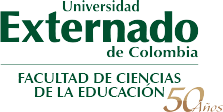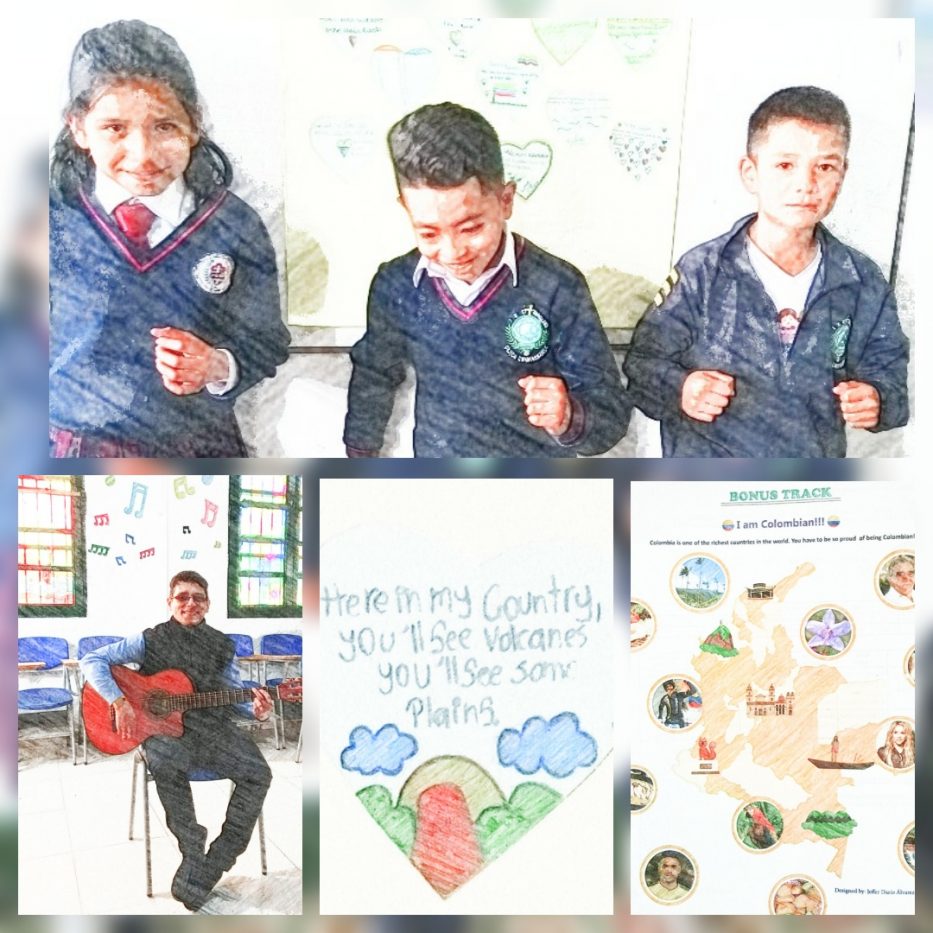5 de noviembre de 2018
Teacher-Composed and Adapted Songs for Vocabulary Learning
Jeffer Darío Álvarez Forero
Teaching English as a foreign language in Colombia demands innovative practices that help students approach the learning of English in different ways. Working as an English teacher and playing music in different places led me to the conclusion that songs and teaching can get along. As a result, I tried to combine them by composing and adapting songs close to their reality to cover related words through lyrics.
After working more than 12 years in private institutions with students who have plenty of opportunities to study, I began working for a bilingual program called Friendly Town (FT), which lasts two months and it has a very different population. The program enrolls around 160 students from the six public schools in Cajicá, Cundinamarca. It is worth mentioning that these students cannot study in a bilingual school, or afford private classes. They just have access to the English lessons they are taught in their schools or when they take part of the program. In sum, I had to take advantage of those eight or nine weeks to teach them enough vocabulary and I thought of using music as a means. Before I continue sharing my experience, I would like to present the advantages that songs and teaching vocabulary have.
Songs are influential and they can be used when teaching English as a foreign language because they reduce anxiety and improve pronunciation. As a matter of fact, songs are useful as “a resource to develop communicative abilities properly in a foreign language” (Duarte, Tinjacá & Carrero, 2012, p. 12), as they “tend to stick to our minds because they use rhymes, a lot of repetitions” (Petrus, 2012, p. 126). Also, “music and singing promote a positive and comfortable classroom milieu for optimal language learning” (Shin, 2017, p. 15), and songs “help establish a feeling for the rhythm and stressing spoken English” (Richards, 1969, p. 162). Altogether, teaching English through songs arises as a good idea when taking them to the classroom as they may enhance vocabulary learning, through rhymes and repetitions that stick to students’ minds on the short and long-term memory, reducing anxiety and promoting a comfortable environment to study.
In relation to vocabulary, it can be defined as “the words we teach in a foreign language” (Ur, 1991). She suggested to “teach pronunciation and spelling; grammar; collocation; aspects of meaning; and word formation” (p. 60). In the same breath, words can be classified into “high frequency words, academic words, technical words, and low frequency words” (Nation, 2001). As FT is a short program, I decided to emphasize on form. From Ur’s point of view (1991), it refers mainly to pronunciation, (“what a word sounds like”) and spelling (“what it looks like”) (p. 60). In addition, it is important to know that “spelling, meaning, or pronunciation can be retrieved from memory” (Carlisle, 2007, p. 82). Finally, Ryder (2003), stated that for teaching vocabulary it is necessary to guess the words, play with them, use them, test students and review the vocabulary. In general, I wanted my students to learn some high frequency words with good pronunciation and spelling and to use them through the songs I composed and adapted for them.
To continue with my personal experience, I saw the opportunity to teach them English through music. In the past, I used to play famous songs based on the topics I taught and I had never thought of the possibility of composing songs for my students. When I started working for FT, I was given the vocabulary I had to teach, and I remember looking for songs that would suit my students’ needs, but nothing seemed to satisfy them. As a consequence, I composed my first song called “The Caterpillar Blues” which is based on Eric Carle’s short-story “The Very Hungry Caterpillar”. At first, I hesitated because I did not know if it would work, but I took the chance and I played the song for my students after telling the story with posters and a puppet. The result: students loved the song.
This situation became the turning point and I wanted to compose and adapt famous songs for them from different musical genres based on their likes. Among those genres I tried blues, pop, cumbia, son cubano, rock, joropo, reggaeton, electronic and reggae based on what they listened to.
So far, I have composed six songs. The first one was “The Caterpillar Blues” (which was mentioned above), “7 big 7” a song about FT’s rules. Rules tend to be boring and I wanted to compose a catchy song that stuck in their memories to reinforce the rules and to use it anytime. It was a success, too. The third one was “Letreo intenso”, a reggaeton song that teaches students the alphabet, starting with the vowels, one by one, and then the consonants by groups of sounds: B, C, D, G, P, T, V, Z; F, L, M, N, S, X; H, J, K; finally, q, w, r and y. The title of the song is a parody to “perreo intenso”, common in reggaeton songs. I took advantage of students’ interests and how this genre is appreciated by them. The fourth one was “My lovely Day”, a son cubano song that tells my daily routine, to have a contextualized tune related to my life and what I feel when they sing my songs. The fifth one is called “We belong to FT”. This one is very special as it tries to make students aware of stopping aggression among themselves. It is joropo and I had in mind a slow version and a fast one. I played both of them and asked them which one they preferred. They chose the fast version. In this song I mention the six schools and the problems I have seen when they interact, mainly when they are in recess. Nowadays, I am working on a reggae song that intends to make them realize how valuable they are and how they can start transforming their contexts with the simplest things in life like smiling, helping each other, respecting, greeting and being grateful for every little thing we are given every day.
Finally, I have adapted some famous songs. The first one I adapted was Michael Jackson’s “Earth song” and it became “Our animals”, a song that teaches the main features of reptiles, birds, mammals and fish, which tries to make students aware of looking after the planet and animals. I also adapted “Yo me llamo cumbia” one of the most famous songs from our country. With the new lyrics I tried to make students feel proud of being Colombian, to help them appreciate our weather, people, race, touristic places, traditional dishes, geography and famous people around the world. The last song was Bon Jovi’s “It’s my life”. It is now called “It’s my job” in which I ask my students what they want to be in the future. Then, I use their names and jobs and turn it into a song. Students just love it when they hear their names. It has a catchy chorus which makes it easy for them to sing along.
To conclude, bringing teacher-composed and adapted songs into the classroom is a good idea when teaching English as a foreign language. Teachers can benefit from their advantages to vocabulary learning. Also, students love it when the lyrics are close to their lives (school, friends, teachers, town, country) and they sing them enthusiastically. I would like to invite English teachers who play any musical instruments to try to do the same with your students because it is really worth it. A suggestion I have is to use visual aids such as posters, pictures, flashcards and always make a warm-up that motivates them. It is demanding, but they will be grateful, and that experience is priceless.
References
Bon Jovi, J., Sambora, R & Martin, M. (2000). It’s my life [Recorded by Bon Jovi].
On Crush [CD single]. New York, USA: Island Records. (May 23rd, 2000)
Carlisle, J. (2007). Fostering morphological processing, vocabulary development, and reading comprehension. In Guilford Press (Ed.), Vocabulary acquisition: Implications for reading comprehension. (pp. 78-103). New York, USA: The Guilford Press.
Duarte, M., Tinjacá, L., & Carrero, M. (2012). Using songs to encourage sixth graders to develop English speaking skills. PROFILE Issues in Teachers’ Professional Development, 14(1), 11-28.
Gareña, M. (N.A). Yo me llamo cumbia [Recorded by Mario Gareña].
On Colombia de Gala International Version [Spotify playlist]. Universal Music Colombia. (2012)
Jackson, M. (1995). Earth song [Recorded by Michael Jackson].
On HISTory [CD single]. Los Angeles, CA: Epic Records. (1989-1991 1994-1995)
Nation, P. (2001). Learning vocabulary in another language. Cambridge, UK: Cambridge University Press.
Petrus, R. (2012). Exploring intercultural awareness through songs. Neue Didaktik, 1, 125-136.
Richards, J. (1969). Songs in language learning. Teachers of English to Speakers of Other Languages, 3(2), 161-174.
Ryder, A. (2003). Abra vocabra: The amazingly sensible approach to teaching vocabulary. Fort Collins, CO: Cottonwood Press.
Shin, J.K. (2017). Get up and sing! Get up and move! Using songs and movement with young learners of English. English Teaching Forum, 55(2), 14-25
The Very Hungry Caterpillar. (n.d.). Retrieved from https://es.slideshare.net/samanthamorris211/the-very-hungry-caterpillar-7574597
Ur, Penny. (1991). A course in language teaching: practice and theory. Cambridge teacher training and development: Cambridge, UK: Cambridge University Press.


